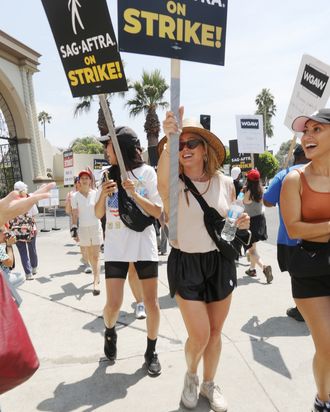
After nearly four months, one of the longest work stoppages in Hollywood history is coming to an end. On Wednesday, SAG-AFTRA, the union that represents some 160,000 performers, announced that it has reached a tentative deal with major Hollywood studios. That means actors can soon get back to work and that new shows and movies can resume production.
Although details of the negotiated contract are still under wraps and will be revealed only when it goes to the board on Friday, SAG-AFTRA described the agreement — purportedly valued at more than $1 billion — as being of “extraordinary scope.” The union said it includes “‘above-pattern’ minimum compensation increases, unprecedented provisions for consent and compensation that will protect members from the threat of AI, and for the first time establishes a streaming participation bonus.” Once leadership signs off on the deal and actors vote on it, everyone can get back to work, though the strike technically ended at 12:01 a.m. PT.
The conflict between studios and performers began in June, when nearly 98 percent of the union voted to authorize a strike ahead of their contract’s expiration. On June 7, SAG sat down to start negotiating a new deal with the Alliance of Motion Picture and Television Producers (AMPTP), a trade association that represents Paramount, Sony, Universal, Disney, Warner Bros., ABC, NBC, Fox, Netflix, Apple TV+, and Amazon, among others.
According to the New York Times, SAG-AFTRA presented the AMPTP with a 48-page proposal that focused mainly on higher pay, better residuals for movies and shows on streaming services, and assurances that their jobs would not be taken over by AI. Negotiations dragged on for weeks, with both parties digging in their heels. In late June, over 1,000 performers signed a letter to guild leadership saying they were “prepared to strike” amid the ongoing talks. Before the contract expired on June 30, SAG-AFTRA and the AMPTP agreed to extend negotiations until July 12, at which point they still hadn’t reached an agreement and reportedly brought in a federal mediator. The expiration date came and went, and on July 13, SAG-AFTRA’s national board gathered at its Los Angeles headquarters, voting unanimously to strike. Major Hollywood talent threw their support behind SAG-AFTRA’s negotiators and took to the streets to picket.
The strike started at midnight July 14, and actors put all work on pause, including promotion of their new and upcoming projects. Per the guild’s stipulations, almost all performance and promotion engagements were off-limits: acting, singing, dancing, stunts, voice acting and narration, rehearsing, stand-in or background work, auditioning, and even more niche jobs like “puppeteering” and “piloting on-camera aircraft.” SAG-AFTRA did, however, issue waivers to some indie studios (such as A24) that aren’t part of AMPTP, allowing them to continue filming certain projects. It also shared guidelines for influencer members, who were able to continue their brand partnerships. The picketers joined members of the Writers Guild of America, who had, at that point, been on strike for more than two months over similar contract concerns: the threat of AI, better compensation, and more safeguards to prevent studios from underpaying their workers.
From the start, it looked as though the work stoppage would be a long one: In July, Disney CEO Bob Iger called the strike “very disturbing” and deemed the union’s demands “not realistic.” In a statement released just before the decision to strike was announced, the AMPTP claimed that it had offered negotiators “historic pay and residual increases, substantially higher caps on pension and health contributions, audition protections, shortened series option periods, and a groundbreaking AI proposal that protects actors’ digital likenesses.” Responding to that statement, SAG’s chief negotiator, Duncan Crabtree-Ireland, told reporters that the “groundbreaking” AI proposal would have paid background actors for one day of work, scanned their faces, and then let the company “own that scan, their image, their likeness and to be able to use it for the rest of eternity in any project they want with no consent and no compensation.”
Before the strike began, the SAG-AFTRA Foundation reportedly wrote 2,700 of the union’s highest-paid members, asking them to help support their lower-earning colleagues during the work stoppage. In an interview with Variety, foundation president Courtney B. Vance and executive director Cyd Wilson emphasized that the majority of SAG’s members are not huge-name actors with massive incomes; they’re people working multiple jobs to float a film career, who suddenly found themselves missing a sizable chunk of their income for however long negotiations went on. Vance and Wilson were therefore soliciting contributions to the Emergency Financial Assistance Program and received a reported $15 million from A-listers in just three weeks.
As the strike wore on, the union faced pressure to reach a deal with studios, particularly after the writers’ strike ended in September. While the AMPTP resumed long-stalled talks with SAG in early October, negotiations quickly broke down again with the guild accusing the studios of using “bullying tactics” to get their way. Also last month, a handful of big-name celebs — including George Clooney, Ben Affleck, and Scarlett Johansson — presented SAG with a proposal they intended to speed along negotiations, under which the guild would scrap caps on membership dues and the industry’s highest-earning stars would pay more. SAG reportedly vetoed that pitch, saying it “didn’t see the validity.”
Notably, Wednesday’s deal doesn’t seem to have satisfied every demand the union had. Shaan Sharma, a member of SAG’s negotiating committee, indicated to the New York Times that he felt ambivalent about the compromise, explaining, “They say a negotiation is when both sides are unhappy because you can’t get everything you want on either side. You can be happy for the deal overall, but you can feel a sense of loss for something that you didn’t get that you thought was important.”
Meanwhile, on X (formerly Twitter) and elsewhere, many union members celebrated the strike’s end, with union president Fran Drescher writing on Instagram, “We did it!!!!” and thanking SAG-AFTRA members “for hanging in and holding on for this historic deal!”
This article has been updated.




